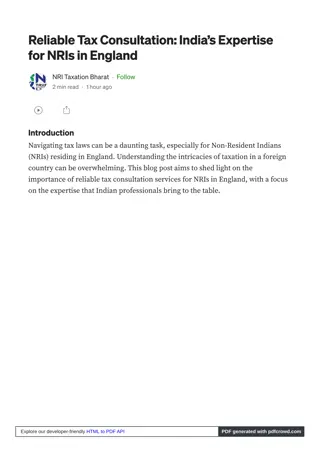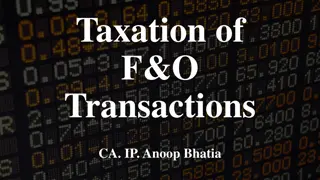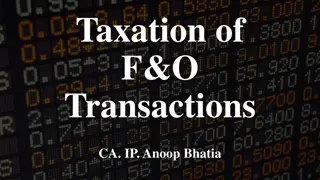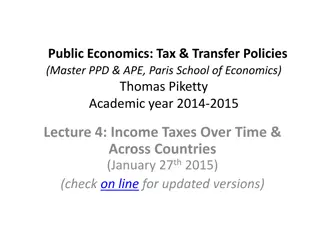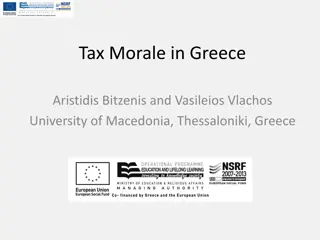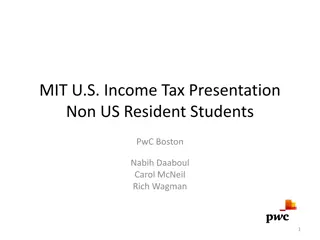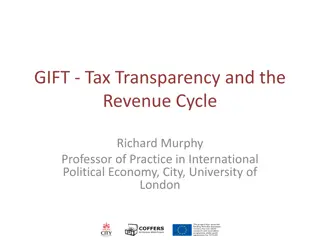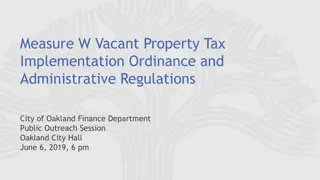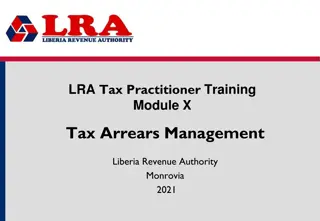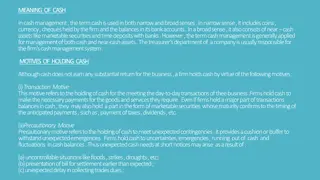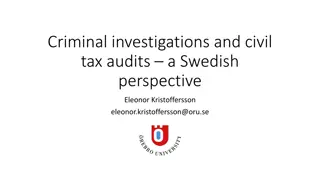Understanding Financial Transactions Tax: Motives, Effects, and Implementation
This workshop delves into the motivations behind a general financial transactions tax (FTT), its potential impact on stabilizing asset prices, revenue generation possibilities, and challenges in implementation. Topics include fundamentalist and bull-bear hypotheses, the role of technical trading, FTT revenues estimates, and models of asset price behavior.
- Financial transactions tax
- Asset prices
- Trading strategies
- Revenue potential
- Implementation challenges
Download Presentation

Please find below an Image/Link to download the presentation.
The content on the website is provided AS IS for your information and personal use only. It may not be sold, licensed, or shared on other websites without obtaining consent from the author. Download presentation by click this link. If you encounter any issues during the download, it is possible that the publisher has removed the file from their server.
E N D
Presentation Transcript
A General Financial Transactions Tax Motives, Stabilizing Effects, Revenue Potential and Implementation Issues Stephan Schulmeister Workshop in Copenhagen on January 18, 2011
Introduction: A puzzle and some questions Trading more and more short-term oriented ( faster ) Asset prices move in long-term bulls and bears What is the role of technical /algorithm trading? Why has it become so popular? How are bulls and bears brought about? Would an FTT dampen asset price volatility? How would it affect useful transactions as hedging? What would the FTT revenues be? How could an FTT be implemented? 1
Overview Fundamentalist hypothesis and bull-bear- hypothesis Profitability and price effects of technical trading systems Measurement of asset prices paths Overshooting of asset prices and the crisis Concept of a general transaction tax Estimates of FTT revenues Implementation of an FTT 2
Fundamentalist hypothesis I Theoretical benchmark model ("world 0"): Frictionless market Perfect knowledge No transaction costs Fundamentalist model ("world I"): Transaction costs Actors are fully rational Do not know the expectations of other actors > Gradual price discovery process 3
Fundamentalist hypothesis II High transaction volumes stem from market makers They provide liquidity for convergence to fundamentals Speculation necessary and stabilizing No endogenous overshooting Deviations from fundamentals are due to shocks Asset prices follow a random walk Speculation based on past prices not profitable 4
Bull-bear-hypothesis I Imperfect knowledge > Different models and information sets Rational, emotional and social factors govern behaviour Expectations often formed only qualitatively (directional) Trading volume expands due to bets of actors with heterogenous expectations Price movements lengthened by technical trading 5
Bull-bear-hypothesis II Dominance of "bullish" or "bearish bias in expectations Price runs in line with "market mood" last longer than counter-movements > "Bull markets" and "bear markets" > Asset prices move in irregular cycles around fundamentals No tendency to converge Fundamentals serve as "center of gravity" 6
Three paths of asset prices Price O 110 K 108 J I 106 M C D B 104 102 E F G H 100 A 98 L Time 96 7 1 2 3 4 5 6 7
"Bulls" and "bears" in the US stock market Daily price of the S&P 500 100-days moving average 10/9/2007, 1565.15 1600 3/24/2000, 1527.46 1400 S 1/19/2010, 1150.23 1200 S&P 500 S 1000 L L 800 10/7/2002, 785.28 3/9/2009, 676.53 600 11/23/1994, 449.93 400 1994 1996 1998 2000 2002 2004 2006 2008 2010 8
S&P 500 futures prices July and August, 2000 1540 30-minutes price 15-period moving average (MAL) S 1520 1500 S 1480 L L 1460 L 1440 1420 9
Dynamics of the dollar/euro exchange rate 4/22/2008, 1.601 Daily price 50-day moving average (MAL) 1.6 12/3/2009, 1.5081 1.5 12/30/2004, 1.3623 1.4 1.3 2/18/2009, 1.2547 10/27/2008, 1.2446 1.2 11/14/2005, 1.1667 1.1 1.0 0.9 1/31/2002, 0.8594 10/26/2000, 0.8271 0.8 1999 2001 2003 2005 2007 2009 10
5-minutes dollar/euro rate June, 6-13, 2003 5-minute price 1.19 35-period moving average (MAL) 1 3/21 :55 6/9:1 0 9/1 3:1 0 1 1 /1 3:45 1.18 1 3/1 2:35 1.17 6/1 4:1 5 9/6:55 1 1 /1 :50 1.16 11
Technical oil futures trading 2007- 2009 Daily price 15-day moving average (MAS) 60-day moving average (MAL) 150 140 130 120 110 S(1/25/2008) 100 $ per barrel L(2/21/2008) 90 80 L(9/7/2007) 70 S(8/27/2007) 60 50 40 30 12
Trading signals and oil price dynamics 145 WTI crude oil futures contract 135 125 115 $ per barrel 105 2/21/2008 95 85 2/7/2008 75 Net position index of 1092 technical trading systems Reihe2 100 0 -100 13
CDS-speculation, interest rate hike and the debt crisis - Greece 13 CDS premia (left scale) Bond rates (right scale) 1,000 900 12 800 11 700 10 Basic points 600 9 In % 500 8 400 7 300 6 200 5 100 4 0 1/1/09 4/1/09 7/1/09 10/1/09 1/1/10 4/1/10 7/1/10 10/1/10 14 Q: 05.10.2024
CDS-speculation, interest rate hike and the debt crisis - Ireland 9 CDS premia (left scale) Bond rates (right scale) 1,000 900 8 800 700 7 Basic points 600 In % 500 6 400 300 5 200 100 4 0 1/1/09 4/1/09 7/1/09 10/1/09 1/1/10 4/1/10 7/1/10 10/1/10 15 Q: 05.10.2024
Dollar/euro exchange rate and purchasing power parity PPP of tradables Exchange rate $/ (ECU) 1.6 1.5 1.4 1.3 Dollar per Euro/ECU 1.2 1.1 1.0 0.9 0.8 0.7 1970 1975 1980 1985 1990 1995 2000 2005 2010 16
Dollar exchange rate and oil price fluctuations Effective dollar exchange rate 1) Oil price (right scale) 150 100 140 90 130 80 120 70 110 60 1986 = 100 100 50 In $ 90 40 80 30 70 20 60 10 50 0 1967 1973 1979 1985 1991 1997 2003 2009 1) Vis-a-vis DM, Franc, Pound, Yen. 17
Wealth of private household in the US Financial wealth (stock related) 1) Real estate 320 270 In % of disposable income 220 170 120 1990 1992 1994 1996 1998 2000 2002 2004 2006 2008 18
Overall financial transactions in the world economy 90 Total 60 Stocks and bonds (spot) Spot markets 80 Foreign exchange (spot) Derivative markets 50 70 Exchange-traded derivatives OTC derivatives 60 40 World-GDP = 1 World-GDP = 1 50 30 40 30 20 20 10 10 0 0 1990 1992 1994 1996 1998 2000 2002 2004 2006 2008 2010 1990 1992 1994 1996 1998 2000 2002 2004 2006 2008 2010 19
High-frequency flash trading 9:31:00,01 -9:31:00,03 A.M. FAST TRADERS GET TO PREVIEW ORDERS 9:31:00,30 A.M. MUTUAL FUND ORDER EXECUTED SHARE PRICE $21.02 9:31:00,00 A.M. INVESTOR SUBMITS ORDER 9:31:00,01 -9:31:00,03 A.M. TRADERS BUY $21.01 $21.00 I I I I I I 0.1 0.0 0.2 0.3 0.4 0.5 ELAPSED TIME SECONDS SECONDS 20
Some conclusions Growing discrepancy between real and financial transactions. Speculation on derivatives exchanges grows fastest. Asset prices fluctuate in a sequence of bulls and bears . Due to the accumulation of short-term price runs. A FTT would affect specifically very short-term transactions with high leverage > Dampens long-term asset price fluctuations. 21
Motivation of proposing a FTT Target 1: Stabilization of exchange rates, commodity prices and stock prices: Short-term volatility Extent of booms/busts over the long run > Dampen the manic-depressive fluctuations Target 2: Generating revenues for Fiscal consolidation Other policy goals, in particular at the supranational level (EU budget, development aid) 22
Concept of a general FTT Generalizes the Keynes-Tobin-concept: All financial assets treated equally Three tax rates: 0,1%, 0,05%, 0,01% of (notional) value > Higher leverage > higher tax burden on cash requirement (margins) Implementation through electronic settlement systems like TARGET (centralized approach) or through banks/brokers (decentralized approach) Revenue estimates: Three scenarios about the reduction of trading due to the FTT (differentiated by types of instruments 23
Hypothetical FTT receipts in % of GDP at a tax rate of 0.05% World North America Asia and Pacific Europe In % of GDP In % of GDP In % of GDP In % of GDP In Bill. $ In Bill. $ In Bill. $ In Bill. $ Spot transactions on exchanges 0.11 60.9 0.12 21.2 0.18 28.3 0.16 10.3 Derivatives transactions on exchanges 0.65 358.1 0.69 122.7 1.28 198.7 0.51 32.8 0.44 242.0 0.82 145.1 0.33 50.8 0.67 43.6 OTC Transactions 1.21 661.1 1.63 289.0 1.79 277.8 1.34 86.7 All transactions 24
Centralized FTT implementation I FTT is collected at settlement/ territorial principle Debtor is the settling institution Exchange transactions: Electronic platforms OTC-transactions: Central Counterparty Platforms (CCPs) or Central Securities Depositories (CSDs) Prerequisites: All important countries in a trading time zone participate, e. g., EU27 Mandatory clearance of OTC transactions through CCPs/CSDs Standard Classification of Financial Transactions (SCFT) 25
Centralized FTT implementation II Distribution of revenues from exchange transactions: Home country of exchange Country of origin of transactions Supranational institutions/projects (EU and/or ODA) Distribution of revenues from OTC transactions: Country of origin of transactions Supranational institutions/projects (EU and/or ODA) Centralized FTT implementation ideal but hard to realize 26
Decentralized FTT implementation I FTT is deducted by banks (and brokerage firms) Personal principle : Debtor is the resident of an FTT country Customer or proprietary trading Example: Germany introduces an FTT Tax base: Transactions of German residents At home (~15% of Eurex transactions) Abroad, e. g., at London market place 27
Decentralized FTT implementation II No discrimination of German exchanges > 85% of transactions would not be taxed Against tax evasion: FTT substitution levy (FTTSL) on transfers abroad E.g., equivalent of 40 round trips i.e., 2% OTC transactions: A bank is always involved > Tax deduction at/by banks Decentralized approach: Pragmatic, accounts for Political and institutional differences 28
Transactions on exchanges Customers in country A (with FTT) Customers in country B (no FTT) Bank/ Fund in A Broker in A Bank/ Fund in B Broker in B Exchange in country A (with FTT) Exchange in country B (no FTT) Order exempt from FTT Order subject to FTT Payment subject to the FTT substitute levy (FTTSL) 29
Over-the-counter transactions Country A (with FTT) Country B (no FTT) Banks Banks CCPs Other Other financial institutions financial institutions (in an "non FTT-country") Non- financial institutions Non- financial institutions Transaction exempt from FTT Transaction exempt from FTT 30
ER trends and aggregate positions of TTS Exchange rate A B days C D E F G H I Position index 5 days 100 Cond. 2LA Cond. 2LB Cond. 1LB Cond. 1SA k k i i 0 days k k 5 Cond. 1SB i days Cond. 1LA - 100 i Cond. 2SA Cond. 2SB 31
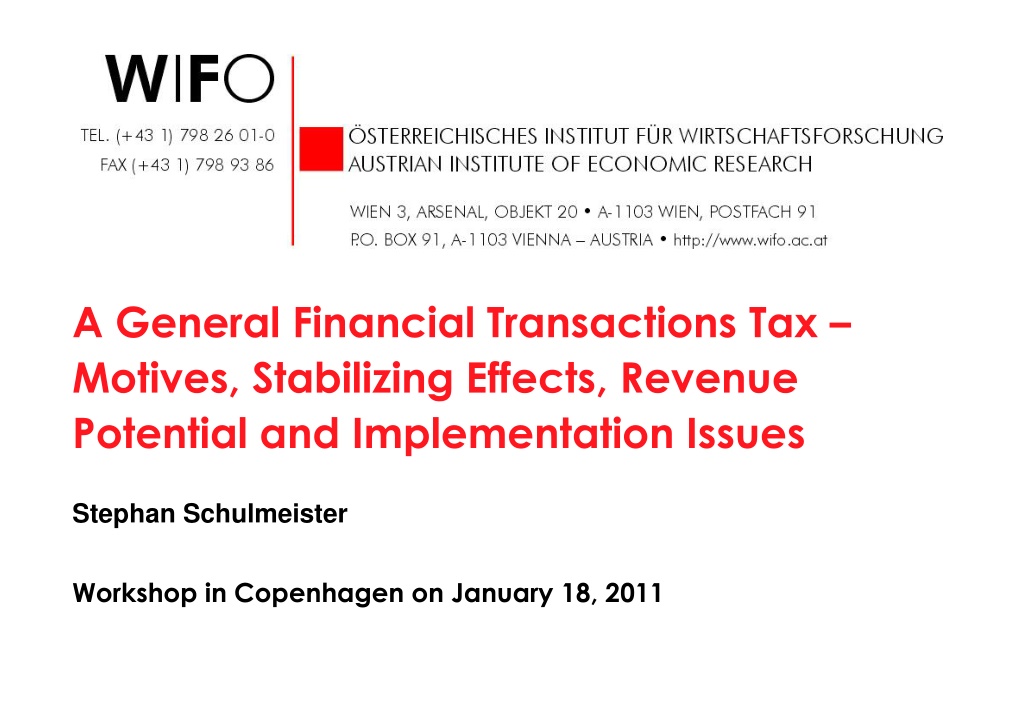


![Town of [Town Name] Real Estate Tax Rates and FY 2024 Budget Summary](/thumb/62211/town-of-town-name-real-estate-tax-rates-and-fy-2024-budget-summary.jpg)
